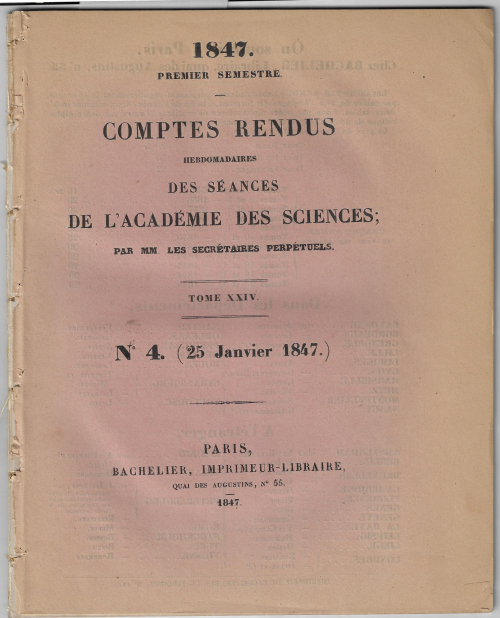 Blanquart-Evrard, "Procedes employes pour obtenir les epreuves de photographie sur papier, in Comptes Rendus hebdomadaires des Seances de l'Academie des Sciences, vol XXIV/4, 25 January 1847, occupying pp 117-123 in the issue of pp 85-125. Extracted from a larger bound volume, and offered with the original front wrapper (detached). Good copy.
Blanquart-Evrard, "Procedes employes pour obtenir les epreuves de photographie sur papier, in Comptes Rendus hebdomadaires des Seances de l'Academie des Sciences, vol XXIV/4, 25 January 1847, occupying pp 117-123 in the issue of pp 85-125. Extracted from a larger bound volume, and offered with the original front wrapper (detached). Good copy.
Offered with:
Blanquart-Evrard, "Supplement a une precedente communication concernant la photographie sur papier", in Comptes Rendus....(as above), Vol XXIV/15, 12 April 1847, is being a short note on p. 653 in the issue of 639-659pp. Extracted from a larger bound volume, and offered with the original front wrapper (detached). Good copy.
The two papers: $750
“In 1847 Blanquart-Evrard became the first to publish the procedure for the calotype negative/positive paper process in France...In December 1846, he accepted an invitation from the Academie des Sciences to present his research findings, and submitted several of the prints he made to an enthusiastic audience. He never publicly acknowledged the similarities between his and Mr. Talbot's processes, but Mr. Blanquart-Evrard's improvements are undeniable. He floated the paper into a silver solution instead of brushing it on, which sensitized the paper and produced better quality prints. He also learned that adding only gallic acid as a developing agent after exposure, not only was the exposure time reduced, but a much clearer print was produced. Mr. Blanquart-Evrard received a patent for his process in 1847, and two years later he revealed his perfected version of Joseph Niepce de St. Victor's negative-on-glass process.” http://www.historiccamera.com
Helmut Gernsheim (History of Photography) notes that this publication by Blancquart-Evrard (along with his 1851 paper "Photographie sur papier" in 1851 "marked the beginning of a new era of photography" by introducing a "very considerable improvement of Talbot's calotype process". The calotype process offered very contrasty images and were lacking in half-tone sensibilities; "the paper ("wet process") approach by Blancquart-Evrard, which provided a (paper) surface impregnated with silver nitrate (and therefore much more light-sensitive), was much more able to reveal tone and detail.”



Comments